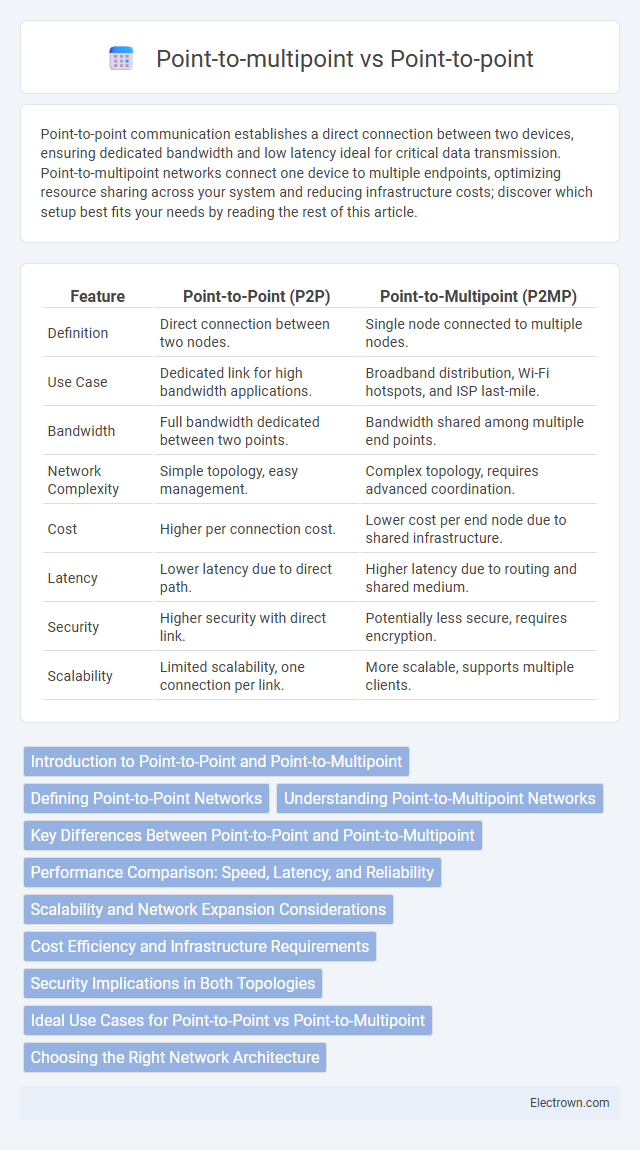Point-to-point communication establishes a direct connection between two devices, ensuring dedicated bandwidth and low latency ideal for critical data transmission. Point-to-multipoint networks connect one device to multiple endpoints, optimizing resource sharing across your system and reducing infrastructure costs; discover which setup best fits your needs by reading the rest of this article.
Table of Comparison
| Feature | Point-to-Point (P2P) | Point-to-Multipoint (P2MP) |
|---|---|---|
| Definition | Direct connection between two nodes. | Single node connected to multiple nodes. |
| Use Case | Dedicated link for high bandwidth applications. | Broadband distribution, Wi-Fi hotspots, and ISP last-mile. |
| Bandwidth | Full bandwidth dedicated between two points. | Bandwidth shared among multiple end points. |
| Network Complexity | Simple topology, easy management. | Complex topology, requires advanced coordination. |
| Cost | Higher per connection cost. | Lower cost per end node due to shared infrastructure. |
| Latency | Lower latency due to direct path. | Higher latency due to routing and shared medium. |
| Security | Higher security with direct link. | Potentially less secure, requires encryption. |
| Scalability | Limited scalability, one connection per link. | More scalable, supports multiple clients. |
Introduction to Point-to-Point and Point-to-Multipoint
Point-to-Point (PtP) communication establishes a direct link between two nodes, enabling dedicated and secure data transfer with high bandwidth efficiency. Point-to-Multipoint (PtMP) architectures connect one central node to multiple endpoints, optimizing network resource distribution and supporting scalable connections for applications like wireless broadband and IoT networks. Both topologies serve different use cases, with PtP ideal for high-capacity links and PtMP suited for broad coverage and shared access environments.
Defining Point-to-Point Networks
Point-to-point networks establish a direct, dedicated communication link between two nodes, ensuring high-speed, secure data transfer with minimal interference. These connections are ideal for linking two fixed locations such as two offices or data centers, providing reliable, low-latency performance. Understanding the differences between point-to-point and point-to-multipoint networks helps you select the optimal architecture for your specific connectivity requirements.
Understanding Point-to-Multipoint Networks
Point-to-multipoint networks enable a single central node to communicate simultaneously with multiple remote nodes, optimizing bandwidth use and reducing infrastructure costs compared to point-to-point links. This topology is commonly used in wireless communication, such as Wi-Fi access points, where one base station connects to several devices. Understanding the scalability and efficiency of point-to-multipoint networks is crucial for applications in telecommunications, broadband distribution, and remote monitoring systems.
Key Differences Between Point-to-Point and Point-to-Multipoint
Point-to-point (PTP) connections establish a dedicated communication link between two devices, ensuring high security and consistent bandwidth ideal for private networks. In contrast, point-to-multipoint (P2MP) setups transmit data from a single source to multiple devices, optimizing resource allocation for applications like wireless internet service providers. Understanding these key differences helps you select the most efficient network topology tailored to your connectivity and scalability requirements.
Performance Comparison: Speed, Latency, and Reliability
Point-to-point connections typically offer higher speed, lower latency, and more reliable communication due to their dedicated link between two devices, minimizing interference and bandwidth sharing. In contrast, point-to-multipoint networks distribute a single communication channel among multiple recipients, which can lead to variable speeds, increased latency, and potential reliability issues under heavy load or interference. Performance in point-to-multipoint systems largely depends on network topology, traffic management, and environmental factors, making them less predictable than the inherently stable point-to-point links.
Scalability and Network Expansion Considerations
Point-to-point networks offer limited scalability as each new connection requires dedicated hardware and direct links, making network expansion costly and complex. Point-to-multipoint architectures enhance scalability by allowing multiple devices to share a single communication channel, significantly reducing infrastructure expenses and facilitating easier network growth. This model supports more flexible network expansion, accommodating a larger number of nodes with less physical wiring and improved resource allocation.
Cost Efficiency and Infrastructure Requirements
Point-to-point connections offer higher cost efficiency for long-distance, dedicated links by minimizing equipment at each endpoint but require substantial infrastructure investment for each individual link. Point-to-multipoint systems reduce overall infrastructure needs by sharing a single transmitter across multiple receivers, lowering deployment and maintenance costs in broadband access and wireless distribution networks. Cost efficiency in point-to-multipoint setups improves with scale, while point-to-point remains ideal for high-capacity, low-latency connections despite higher per-link infrastructure costs.
Security Implications in Both Topologies
Point-to-point (PtP) topologies enhance security by establishing a dedicated, direct communication link between two devices, minimizing the risk of unauthorized access and data interception. Point-to-multipoint (PtMP) configurations introduce greater security challenges, as multiple devices share a single communication channel, increasing vulnerability to eavesdropping and unauthorized connections without robust encryption and authentication protocols. Implementing strong encryption standards like AES and stringent access controls is crucial in PtMP networks to mitigate the inherent risks posed by their shared medium architecture.
Ideal Use Cases for Point-to-Point vs Point-to-Multipoint
Point-to-point connections are ideal for securely linking two locations with high bandwidth requirements, such as connecting two corporate offices or data centers. Point-to-multipoint networks efficiently support multiple endpoints, making them suitable for wireless internet service providers delivering broadband to various customer premises. Enterprises leverage point-to-multipoint setups for scalable communication in campus networks, while point-to-point is preferred for dedicated, high-speed links.
Choosing the Right Network Architecture
Selecting the right network architecture depends on the specific application needs, with point-to-point providing dedicated, high-bandwidth connections ideal for secure data transfer between two locations. Point-to-multipoint networks offer scalable communication, allowing a single source to efficiently serve multiple receivers, which is essential in wireless broadband and broadcast environments. Evaluating factors such as range, bandwidth requirements, cost, and deployment complexity guides the choice between these architectures to optimize performance and resource utilization.
Point-to-point vs Point-to-multipoint Infographic

 electrown.com
electrown.com